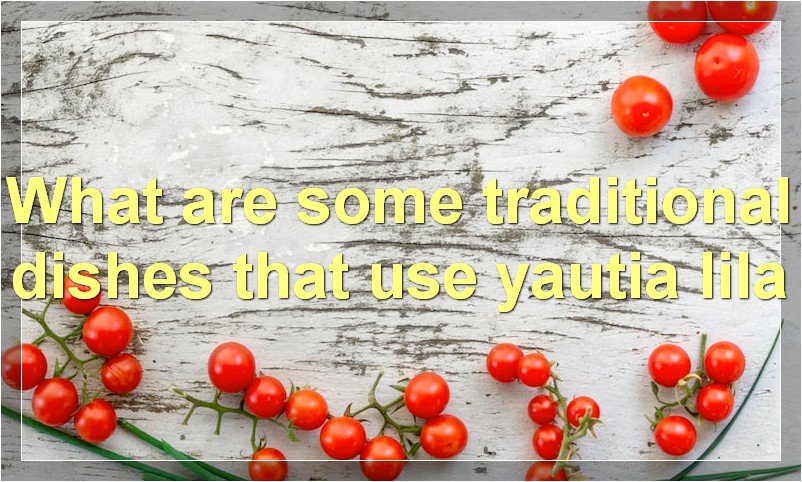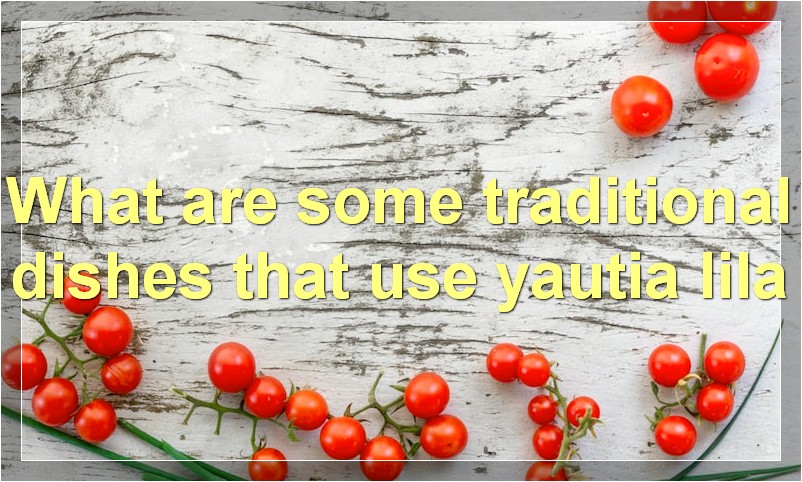If you’re looking for a delicious, nutritious, and versatile root vegetable, look no further than yautia lila. Yautia lila, also known as malanga or coco, is a staple in many traditional dishes and has a host of health benefits. Here are just a few reasons why you should start incorporating yautia lila into your diet.
What are the nutritional benefits of yautia lila
When it comes to nutrient-rich vegetables, yautia lila (Xanthosoma violaceum) is hard to beat. This tropical tuber is an excellent source of fiber, vitamins and minerals. It also contains a unique type of starch that may offer health benefits.
Yautia lila is native to the Caribbean and South America. It’s also known as malanga lila, new cocoyam, purple taro and violet corm.
This starchy vegetable has a thick, brown skin and purple flesh. It’s often used in soups, stews and curries. Yautia lila can be eaten boiled, baked or mashed.
The nutrient content of yautia lila varies depending on how it’s prepared. For example, boiling yautia lila significantly reduces its vitamin C content. However, baking or frying does not appear to have the same effect (1).
Here are some of the key nutrients in yautia lila (2):
Fiber: 6 grams in a 1-cup (150-gram) serving.
Vitamin C: 28% of the Reference Daily Intake (RDI) in a 1-cup (150-gram) serving.
Vitamin B6: 20% of the RDI in a 1-cup (150-gram) serving.
Potassium: 18% of the RDI in a 1-cup (150-gram) serving.
Folate: 12% of the RDI in a 1-cup (150-gram) serving.
Magnesium: 8% of the RDI in a 1-cup (150-gram) serving.
Yautia lila is an excellent source of dietary fiber. Fiber is a type of carbohydrate that your body cannot digest. It passes through your digestive system mostly intact and helps add bulk to your stool (3).
A high-fiber diet has been linked to several health benefits, including weight loss, improved digestion and reduced blood sugar levels (4). What’s more, fiber may help reduce your risk of heart disease and certain types of cancer (5).
In addition to being high in fiber, yautia lila is also a good source of vitamins and minerals. For example, it’s rich in vitamin C, which is important for immunity and collagen production (6).
Yautia lila also contains a type of starch called resistant starch. This type of starch resists digestion and acts like fiber in your digestive system (7).
Resistant starch has been linked to several health benefits, including improved blood sugar control, reduced inflammation and improved gut health (8). However, more research is needed to confirm these effects in humans.
What are some traditional dishes that use yautia lila
Yautia lila, also known as purple yam, is a popular root vegetable in many Caribbean and Latin American countries. It is often used in traditional dishes such as stews, soups and casseroles.
Yautia lila has a deep purple skin and white flesh. It is slightly sweeter than other yams and has a nutty flavor. When cooked, it turns a deep purple color.
Yautia lila is a good source of dietary fiber, vitamins A and C, potassium and manganese. It can be enjoyed baked, boiled, mashed or roasted.
Here are some traditional dishes that use yautia lila:
1. Puerto Rican Puerto Rican Cuisine stew: This dish is made with chicken, pork or beef, yautia lila, green bananas, plantains, potatoes, squash, corn and pigeon peas. It is typically flavored with sofrito (a blend of garlic, onions, green peppers and cilantro) and sazón (a seasoning blend of cumin, coriander, annatto and garlic).
2. Cuban mojo de yuca: This dish is made with yautia lila, cassava, onion, garlic, lime juice, cumin and olive oil. It is typically served as a side dish or appetizer.
3. Dominican sancocho de yuca: This soup is made with yautia lila, cassava, chicken, beef or pork, vegetables (such as potatoes, carrots, onions and cabbage) and spices (such as cumin and oregano).
4. Haitian bouillon de poulet aux navets: This soup is made with chicken, yautia lila, turnips, carrots, celery, onions, garlic and parsley.
5. Jamaican curry goat: This dish is made with goat meat that has been marinated in a curry mixture of spices (such as chili powder, cumin, coriander and cloves), then slow-cooked with potatoes, yams, carrots and onions.
6. Trinidadian callaloo: This dish is made with greens (such as spinach or amaranth), yams, coco milk, crab or shrimp, hot peppers and spices (such as thyme, basil and garlic).
How can I incorporate yautia lila into my diet
When it comes to incorporating yautia lila into your diet, there are a few things to keep in mind. For one, yautia lila is a great source of dietary fiber. This means that it can help to regulate your digestion and keep you feeling fuller for longer periods of time. Additionally, yautia lila is also a good source of vitamins and minerals, including calcium, potassium, and iron. As such, it can be a great addition to any healthy diet.
There are a few different ways that you can incorporate yautia lila into your diet. One option is to simply add it to your regular meals. For example, you could add yautia lila to a stir-fry or include it in a soup or stew. Another option is to make yautia lila the star of the show by preparing it as a main dish. There are many recipes available online that showcase how to do this.
No matter how you choose to incorporate yautia lila into your diet, it is sure to be a delicious and nutritious addition. So why not give it a try today?
What are the health benefits of yautia lila
Yautia lila, also known as Malanga and Cocoyam, is a root vegetable that is grown in tropical climates. The health benefits of yautia lila are numerous, and this vegetable has been used for centuries in traditional medicine to treat a variety of ailments.
Yautia lila is rich in vitamins and minerals, including vitamin C, potassium, and magnesium. It is also a good source of dietary fiber.
The health benefits of yautia lila include:
1. Boosting immune system function: Vitamin C is essential for immune system function, and yautia lila is a great source of this nutrient.
2. Supporting cardiovascular health: Potassium is an important mineral for maintaining healthy blood pressure levels.
3. Promoting healthy digestion: Dietary fiber helps to keep the digestive system regular and can help to prevent constipation.
4. Reducing inflammation: Magnesium has anti-inflammatory properties and can help to reduce inflammation throughout the body.
5. Managing diabetes: Yautia lila has a low glycemic index, which means it does not cause spikes in blood sugar levels. This makes it an excellent food for diabetics or those at risk of developing diabetes.
6. Regulating cholesterol levels: The fiber in yautia lila can help to lower cholesterol levels by binding to LDL cholesterol and removing it from the body.
7. Cancer prevention: Some studies have shown that the antioxidants in yautia lila may help to protect against certain types of cancer.
Is yautia lila good for weight loss
When it comes to weight loss, there is no one-size-fits-all approach. However, adding yautia lila to your diet may help support your weight loss goals. This root vegetable is low in calories and fat but high in fiber and nutrients. Additionally, yautia lila has been shown to help regulate blood sugar levels and promote satiety. As such, including yautia lila as part of a healthy diet may help you lose weight and keep it off over the long term.
What are the side effects of yautia lila
Yautia lila is a tuber that is native to the Caribbean and South America. It is also known as malanga, new cocoyam, tannia, yautía blanca, and yautía lila. The tuber can be eaten raw or cooked and is often used in soups and stews. Yautia lila has a high starch content and is a good source of dietary fiber.
The most common side effect of yautia lila is gastrointestinal upset. This can include bloating, gas, diarrhea, and constipation. Yautia lila can also cause allergic reactions in some people. If you experience any adverse effects after eating yautia lila, discontinue use and consult your doctor.
What is the history of yautia lila
The yautia lila is a root vegetable that is native to South America. It has a long history of being cultivated by the indigenous people of the region. The yautia lila was first brought to Europe by Spanish explorers in the 16th century. It was later introduced to Africa and Asia by Portuguese and Dutch traders. The yautia lila is a member of the yam family and its scientific name is Dioscorea trifida. The root vegetable is also known by a variety of other names, including purple yam, white yam, chenille plant and water yam.
The yautia lila is a starchy root vegetable that is high in carbohydrates. It is typically used as a food source in developing countries. The root vegetable can be boiled, baked, mashed or fried. It is often used in soups, stews and curries. The yautia lila has a nutty flavor and a slightly sweet taste.
The yautia lila is a good source of dietary fiber, vitamins and minerals. It is also low in calories and fat. The root vegetable contains a substance called allantoin, which has been shown to have wound-healing properties.
The yautia lila is grown in tropical regions around the world. It is typically harvested from June to August. The root vegetable can be stored for up to six months if it is kept dry and cool.
How is yautia lila grown
Yautia lila is a tropical plant that is native to Puerto Rico. It is a member of the genus Xanthosoma and the family Araceae. The plant is also known by its common names, such as red yam, purple yam, cambote, and malanga. Yautia lila is a herbaceous perennial that grows to a height of 2-3 meters. The stem is thick and fleshy with large, dark green leaves. The flowers are small and white, borne on a spadix that is surrounded by a large, green bract. The fruit is a yellowish-orange berry that contains many small seeds.
Yautia lila is grown in humid, tropical climates. It prefers rich, well-drained soils and full sun to partial shade. The plant is propagated by seed, division, or root cuttings. Yautia lila is harvested when the tubers are mature, typically after 12-18 months. The tubers are then cleaned, trimmed, and cooked before being eaten.
Yautia lila is a nutritious food source that is high in carbohydrates and dietary fiber. It also contains vitamins A and C, as well as potassium and calcium. Yautia lila can be used in many different dishes, including stews, soups, curries, and roasted.
What are some interesting facts about yautia lila
Yautia lila, also known as taro corm, is a tuberous root vegetable that is commonly used in Caribbean and Latin American cuisine. The yautia lila plant is a member of the Araceae family, which also includes philodendrons and anthuriums. The flesh of the yautia lila tuber can range in color from white to purple, and the flavor has been described as nutty or earthy.
Yautia lila is a nutritious food source that is rich in fiber, vitamins, and minerals. It is a good source of potassium, calcium, and magnesium. The tuber also contains antioxidant compounds that may offer health benefits.
Yautia lila can be cooked in many different ways. It can be boiled, baked, mashed, or fried. The tuber can also be used to make flour or starch. Yautia lila flour is sometimes used as a gluten-free alternative in baking recipes.
The yautia lila plant is native to tropical regions of the Americas. It was introduced to Africa and Asia by Spanish and Portuguese explorers during the 16th century. Today, yautia lila is grown in many countries around the world, including Ecuador, Peru, Brazil, and the Philippines.
How can I use yautia lila in my cooking
Yautia lila, also known as malanga or new cocoyam, is a root vegetable that is popular in Caribbean and Latin American cuisine. It has a nutty flavor and can be used in both sweet and savory dishes.
Yautia lila can be cooked in many different ways. It can be boiled, baked, fried, or even made into a puree. When cooking yautia lila, it is important to remember that it takes longer to cook than other root vegetables. For this reason, it is often best to precook yautia lila before adding it to other dishes.
One of the most popular ways to use yautia lila is in a dish called mofongo. Mofongo is a Puerto Rican dish that consists of mashed yautia lila that is mixed with garlic, olive oil, and pork cracklings. It is then served with meat or seafood.
Yautia lila can also be used in soups, stews, and curries. It pairs well with meats such as chicken, beef, and pork. Yautia lila can also be added to salads or used as a side dish.
If you are looking for a new ingredient to add to your cooking, consider yautia lila. It is versatile and can be used in many different dishes.





